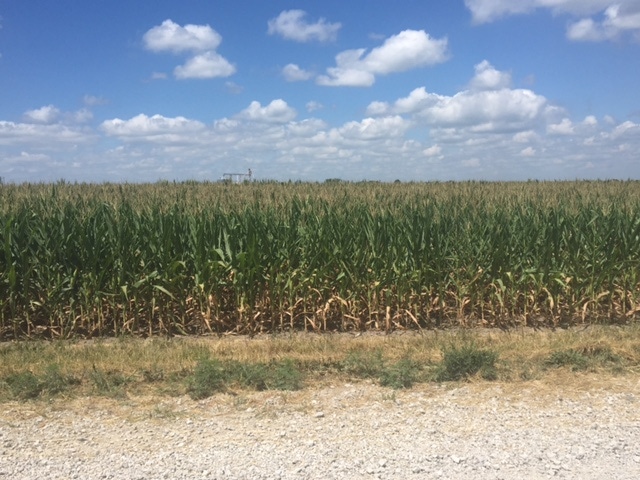
The hot and humid weather created stress for both crops and livestock last week, particularly in areas that have missed the recent rains. South-central Iowa is very dry, with over 90% of topsoil short or very short of moisture.
The complete weekly crop and weather report is available on the Iowa Department of Agriculture and Land Stewardship’s website IowaAgriculture.gov or on USDA’s site nass.usda.gov/ia. The report summary follows here.
Summary of Iowa crop conditions
Above-normal temperatures were accompanied by widely varying rainfall and some severe weather during the week ending July 23, according to USDA’s National Ag Statistics Service. Statewide there were 5.4 days suitable for fieldwork. Activities for the week included hauling grain, applying herbicides and insecticides, cultivating and haying.
Topsoil moisture levels rated 20% very short, 32% short, 45% adequate and 3% surplus on average statewide as of July 23. Over 90% of south-central Iowa’s topsoil falls into the short to very short moisture level categories, while 99% of northeast Iowa’s topsoil is in the adequate to surplus categories. Subsoil moisture levels on average statewide are rated 14% very short, 32% short, 52% adequate and 2% surplus.
Three-quarters of Iowa corn at silking
The weekly survey shows 74% of Iowa’s corn crop has reached silking stage, four days behind last year, but two days ahead of the five-year average. Corn conditions deteriorated slightly to 2% very poor, 6% poor, 24% fair, 55% good and 13% excellent.
Nearly three-quarters of Iowa’s soybean crop was blooming, with 30% of soybeans setting pods, one day ahead of average.
Soybean condition also dropped slightly with 62% rated good-to-excellent. Oats coloring reached 89%, one week behind last year. Forty-one percent of oats for grain or seed have been harvested, four days behind last year. Oat condition rated 71% good-to-excellent. Crops were described as suffering from heat stress and lack of moisture across much of the state.
The second cutting of alfalfa hay reached 90% complete and third cutting reached 8%, which is five days behind average. Hay condition is rated 61% good-to-excellent. Pasture condition continued to decline with just 41% good-to-excellent. High temperatures and humidity were reported to cause normal summer heat stress to livestock, with some reports of heat-related deaths.
Weather summary for Iowa
Harry Hillaker, state climatologist with the Iowa Department of Agriculture and Land Stewardship, provides the following weather summary for the week ending July 23.
It was a hot and humid week across Iowa with exceptionally variable rainfall. Major flooding occurred over parts of northeast Iowa where torrential rains fell July 21 during the day and into the night, while parts of the moderate drought area in south-central Iowa received no rain at all. For the most part the heavier rains fell in what were already the wetter portions of the state. However, portions of the moderate drought area, roughly along U.S. Highway 30 from Crawford to Tama counties, saw some significant rain during the night of July 20.
Wide variation in rain totals this summer
Weekly rain totals varied from none at Murray, Osceola, Chariton and Allerton to 10.12 inches at Ionia in Chickasaw County. Rain totals thus far in July vary from only 0.16 inch at Sioux Rapids and Cherokee to 13.88 inches at Guttenberg. The Guttenberg July total is the highest for any month at that location among 86 years of records, while the Cherokee and Sioux Rapids totals would be record lows for July if no more rain were to fall before the end of the month.
Some of the rain last week was accompanied by severe weather, with the most damaging storms occurring across 15 north-central and northeast counties, roughly north of an Estherville to Dubuque line, on the afternoon and evening of July 18, with widespread high winds of 50 to 70 mph and a few tornadoes. Meanwhile hot weather prevailed with the temperature reaching 95 degrees somewhere in the state each day of the reporting week.
Highest temps in Iowa since 2013
The hottest weather was concentrated across southern Iowa with temperatures for the week averaging from 2 to 3 degrees above normal across the northeast one-third of the state and 5 to 9 degrees above normal across the southwest. Highest temperatures were 101 degree readings at Ottumwa on July 20 and Des Moines on July 21. These were the highest temperatures recorded in Iowa since Sept. 9, 2013. The combination of heat and humidity produced a heat index (how hot the air ‘feels’) of 117 degrees at Clarinda on July 20 and at Harlan on July 21.
Temperatures moderated over the weekend, with Sheldon recording a morning low of 52 degrees on July 24. The statewide average temperature was 5.3 degrees above normal, while rain averaged 1.42 inches compared to a normal of 0.99 inch for the week.
About the Author(s)
You May Also Like




